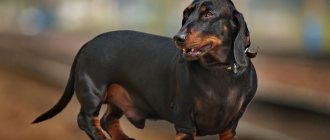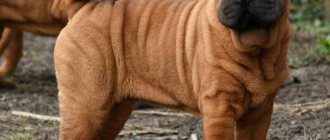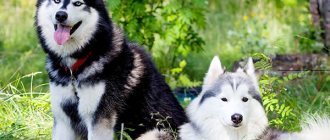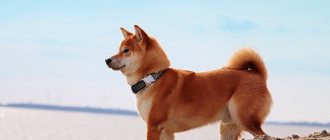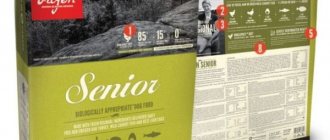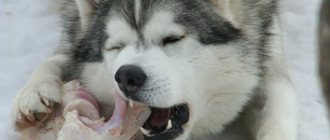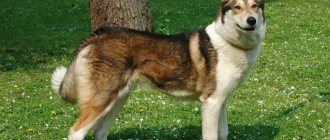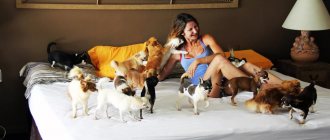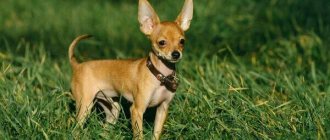The Shiba Inu is an ancient breed of Spitz-shaped hunting dogs, the smallest of the original Japanese (may be confused with the Akita breed). Its homeland is the island of Honshu, where this species was bred more than two and a half thousand years ago. A century ago, the population of the species decreased critically, and in 1928 special measures were taken to continue the species.
Since 1936, the breed has been a national treasure of the Land of the Rising Sun, where today they can often be found in villages. These dogs are beautiful, and with their cunning faces they resemble foxes. A distinctive feature is the donut tail. They are excellent hunters: in the past they were often used to hunt even large animals, such as wild boar, deer, and even bear.
Nowadays they are bred more as companions, and the popularity of the breed has spread far beyond Japan. These animals have adapted perfectly to city apartments, but their instincts are still with them. Quick, active, inquisitive, willful, hardy - that's all about them.
In the third century BC, some of the inhabitants of Korea moved to Japan. They brought dogs with pointed ears and rounded tails. Shiba Inu are mixed breeds of Korean individuals with local village stock.
History of the origin of the breed
The Shiba is a native Japanese breed, its name translates as “small dog”. Previously, the animal lived in the mountains near the Sea of Japan and was used to hunt small animals or birds. Experts say that there are a number of differences in breeds that depend on the conditions of the area in which they appeared.
In everyday life, a dog of this breed is playful and sweet, but in the forest he turns into a sensitive and cunning hunter. The animal has a unique sense of smell and can easily identify game by smell. In Asia, the ancestors of the Shiba were used as a companion for hunting wild boar or bear. The compact animal easily made its way through dense thickets and drove the animal towards its owner. Another version indicates that the name of the dog is translated as “dog from the bush.”
Photo from Wikipedia website
Some people claimed that the purebred animal was bred in temples by Buddhists. Such dogs lived at monasteries, guarding the property of their owners. The peculiarity of the Shiba Inu is that it never barked while the monks were praying. Dogs similar to setters or pointers arrived from Great Britain with their masters, traders or seafarers. Since 1868, representatives of such breeds have been actively crossed with the Shiba Inu in order to obtain the qualities necessary for hunting. Beginning in 1912, there were few purebred Shibas in Japan, and after 10 years they completely disappeared.
After some time, hunting turned into a sport, and educated Japanese began to breed purebred dogs. Already in 1934, scientists presented the first breed standard. After another 3 years, the Shiba received the status of a natural heritage of Japan, after which the breed improved so much that it took the first steps in the ranking of similar dogs.
Characteristics of puppies
Bitches of this breed are caring mothers. They usually have three puppies in a litter.
Already from three months, and sometimes earlier, the cub becomes clean. He will try to relieve himself only on the street and tolerate it at home. He strives for this himself; there is no need to teach him. After a couple of walks, he himself will ask to leave the house to go to the toilet.
IMPORTANT! Animals need to be taught order from a young age. Training is necessary; puppies must master at least basic commands: “Come”, “Place”, “No”. At the stage of 4-5 months, training can be weakened, replacing it with communication with other dogs. It is worth monitoring how actively the puppy is socialized - his comfortable communication with others will simplify life for both him and his owner.
Raising a Shiba Inu is an art. The Japanese compare this process to making origami: to achieve a good result, the owner will need patience, skill, perseverance and caution so as not to damage the fragile product. The ideal relationship with such a dog is a partnership where there is no rudeness or coercion.
Development
The first six months of a cub’s life can be called a period of intensive growth, then there is a noticeable inhibition, and by nine months it is completely completed. Below is a table of the relationship between the puppy's age and its weight.
| Age | Weight |
| 2 months | 3.2 kg |
| 3 months | 3.5 kg |
| 5 months | 4–5 kg |
| 7 months | 6–7 kg |
| 8 months | 8–10 kg |
It is worth keeping in mind that the values are averaged over the population (approximate) and can vary greatly between animals, because each person gains weight differently. To be one hundred percent sure of the health of your four-legged friend, you should consult a veterinarian.
Variability of color
Shibas are big deceivers; their color takes up to two years to develop. You can take a puppy with sesame color and get a red one, and vice versa. They also often have black faces. Most often they lighten, but sometimes the black fur can remain for life.
Breed standard FCI and RKF
The main working characteristics of the breed include medium height, thanks to which an adult dog is able to easily crawl through dense bushes when hunting small animals. In the 30s of the twentieth century, the FCI managed to standardize the description of the Shiba internationally. A number of parameters can be attributed to the characteristics of the breed.
Height and weight
A purebred female at the withers grows up to 37 centimeters, and a male – up to 40 centimeters. Deviations in this parameter are allowed, but only by 1.5 centimeters in any direction. The body weight of animals is 7-13 kilograms, depending on gender.
Body
The Shiba is characterized by a toned body, a flat back, and muscularity in the lumbar region. The dog is distinguished by the presence of a dry belly and deep sternum.
Scull
The Shiba Inu has a strong, triangular head set on a massive neck. The dog's skull and cheekbones are wide, the forehead is flat, the muzzle is pointed, reminiscent of a fox. The animal is characterized by the presence of a sharp transition to the muzzle from the forehead. Also characterized by an exclusively scissor bite without significant overshots.
Ears
Only triangular-shaped ears bent forward are allowed by international and Russian standards. They are dense, fleshy to the touch, erect, not docked.
Eyes
It is allowed to have coffee or brown slanted eyes, the outer corners of which are raised higher than the inner ones. The dog’s organs of vision are necessarily set as deep as possible and squinted.
Photo from Wikipedia website
The highlight of the dog is the sly squinting of the eyes and the edging of the black lips, thanks to which the animal looks laughing.
Nose
The bridge of the nose is parallel to the forehead. The standards highlight the black nose.
Paws
A purebred individual is characterized by massive hock joints, springy pads on the paws, and the presence of dark-colored claws.
Tail
Shiba is distinguished by the presence of a thick, ring-shaped tail, which is densely covered with fluffy hairs. The thick tail necessarily rests on the pet’s back.
Coat and color
The coat of dogs of this breed is abundant, combining a soft undercoat and coarse guard hairs. According to the Shiba Inu breed standard, long hairs are located on the tail, and short hairs are located on the muzzle and paws. Several colors are allowed, but the most popular is red, which is found in 80% of individuals. In second place is black with tanned areas of a silver or red hue. Let's assume a zonal color, in which each hair is colored in 2 different colors, for example, white and black, red and black at the tip of the hair. Dogs of this snow-white breed are not allowed for breeding or participation in dog shows.
According to international standards, the coat of a purebred animal should have “urajiro”, that is, white areas located on the cheekbones, chin, belly, neck, sternum, paws, and tail.
Defects and deviations
If we talk about the RKF standard of the Shiba Inu breed, it must be said that the description of the dog does not allow for the presence of a docked tail or drooping ears. It is worth noting that any deviations from Russian and international standards are considered as a shortcoming, a defect, the severity of which is assessed by its severity. You definitely need to pay attention to how the defect affects the dog’s health.
A deviation from the standard will certainly be problems with bite, that is, overbites or undershots, several teeth are missing. A male-type female, as well as a male that resembles a female, will not be allowed to participate in the dog show. Disqualifying defects include the presence of floppy ears, a short tail, a timid, cowardly or, conversely, too aggressive character.
It is worth noting that a Shiba Inu that has physical or behavioral abnormalities will definitely be disqualified from a dog show. The animal is classified almost identically according to Russian and international standards, so breeders do not have any problems.
What does an adult Shiba Inu look like in a photo?
Shiba Inu are medium-sized dogs, occupying a middle position between small and medium-sized breeds.
The height at the withers for males is 38–41 cm, for females – 35–38 cm . The weight of an adult male is 10-15 kg, females - 8-9 kg. In rare cases, the weight of a Shiba Inu can reach 20–22 kg.
Adult Shiba Inu are dogs with a strong, proportional build, well-fed, but without a tendency to be overweight.
Representatives of nature have a small head, the muzzle is slightly elongated and pointed . The skull is wide with developed cheekbones, the body is slightly elongated relative to the legs.
The eyes are small and brown. The ears are small, erect, triangular in shape. The limbs are strong, but refined. The dog has a strong bone structure, but at the same time it is quite graceful. There is no heaviness or heaviness in it.
The coat of the Japanese husky is thick, dense, and moderately hard . The undercoat is short, soft and dense. The most popular color is red in various variations.
Acceptable colors also include:
- Black and tan.
- Red.
- Sesame (a mixture of black and white hair with a predominance of black).
Care and maintenance
The Shiba Inu dog breed is unpretentious in maintenance, nutrition and care. They, like true samurai, are content with little and adapt to all conditions. Dogs can be kept in an apartment or in a house; in the summer, relocation to an enclosure is also acceptable. The main thing is to allocate a place that will be inviolable for other pets and people.
Pets also adapt to the rhythm of their owner’s life: they can either sleep until lunch and lie on the couch for hours, or walk through the woods all day and accompany the owner while jogging and cycling.
Lying on the bed
Hygiene
Shiba Inus are naturally clean. On the street they walk around puddles, and after a walk they lick their paws. And the dirt that stuck to the fur coat falls off on its own after 15 minutes of being at home.
Difficulties arise only during the molting period. The thick fur sheds abundantly. Therefore, in spring and autumn, dogs are brushed twice a day. It is advisable to do this outside, as the hairs will fly throughout the room.
A lot of work for a powder puffer
The rest of the care is simple:
- Combing. Brush your Shiba Inu twice a week with a thick bristle brush.
- Bathing. Frequent washing is prohibited, as it dries out the skin and spoils the protective lubricant on the coat. Bathing procedures are carried out once a month or less.
- Trimming nails. If they do not grind off on their own, cut them with a claw cutter to a dark place every month. Afterwards, the burrs are removed with a nail file.
- Grooming. Shiba Inus do not need haircuts or trimming. You just need to trim off the overgrown hair between the toes.
- Cleaning the eyes. Since the breed is prone to inflammation of the eyeballs, they are checked every day. Excessive discharge, redness, and swelling should alert you. Once a week, wipe the eyes with veterinary lotion or chamomile decoction.
- Ear cleaning. They also check every day. Alarming signs are redness, itching, copious dark discharge, and an unpleasant odor. Clean once a week with a sponge soaked in veterinary lotion or chlorhexidine.
- Teeth cleaning. Plaque is removed once a week with a toothbrush and toothpaste for dogs. The rest of the time they give toothpicks treats.
- Antiparasitic treatment. Due to the thick and dense fur, blood-sucking parasites on the dog’s body are difficult to notice. But they still check the Shiba Inu every day for fleas and ticks. Be sure to follow the schedule of antiparasitic measures: once a month, apply drops to the withers and poison the helminths every three months.
Toilet
Until 3-4 months, until all vaccinations have been completed and the post-vaccination quarantine has ended, the Shiba Inu puppy cannot be taken outside. At this age he goes to the toilet at home. And it is important to show the baby exactly where to relieve himself.
Immediately determine where the toilet will be and place a disposable diaper there. The place must be accessible to the puppy. As soon as the baby starts spinning, put him there. If you miss a moment, blot the napkin in the puddle and put it where you need it.
puppies and towel
For correct actions, praise your dog profusely and reward him with something special. For example, you can allow him to climb on the bed, give him a favorite treat or toy. It is important that rewards are given only after the toilet, and are not available at other times.
When your Shiba Inu puppy can wear a diaper without any problems, you can replace it with a stable tray with high sides. The scheme is the same: they place a rag or napkin with the smell of urine on the bottom, show it to the baby and praise him for relieving himself.
After three months, the grown puppy begins to be taken outside. The first time, take a dirty diaper with you: the smell will tell the dog what to do. Don't forget about praise. Take your pet out every 3-4 hours: babies cannot stand it for long.
Important! You cannot harshly scold a puppy until it is six months old. His urinary tract is still weak, and the pet cannot always control the process.
From the age of six months, in most cases, the dog must relieve itself outside. But up to a year, mistakes are possible: the pet can make a puddle at home or in the entrance. If this is an accident, do not scold your pet. And leave the toilet at home for an emergency for now.
Feeding
The breed eats little. Therefore, key attention is paid to what to feed the Shiba Inu and the quality of the products.
As for any dog, the basis of natural nutrition is meat and offal. But, given the origin of the breed, they often give low-fat sea fish, boiled rice and seaweed. The rest of the diet consists of vegetables, fruits, cereals, and dairy products.
Watches the food
Do not give your Shiba Inu eggs, sweets, mushrooms, processed foods, long bones or table food.
Note! Japanese dog breeds are often allergic to chicken, and sometimes to beef. Therefore, these products are administered carefully and the pet’s reaction is monitored.
If you plan to feed your Shiba Inu with ready-made diets, choose super-premium or holistic brands. The following foods are suitable for the breed:
- "Orijen" Six Fish;
- "Acana" Heritage Puppy & Junior;
- "Kudo" Cold Pressed Adult Dog;
- "Abba" Fresh Meat;
- "Genesis" Pure Canada Broad Meadow;
- "Grandorf" Junior All Breeds Lamb & Rice Hypoallergenic;
- "Platinum" Adult Dog Iberico & Greens;
- "Wolfsblut" Green Valley.
Walks and trips
Shiba Inus are naturally active and resilient. Therefore, they need significant physical activity and regular walking. This applies equally to dogs living in apartments and outside the city.
Walk your Shiba Inu twice a day for at least an hour. Great ways to provide the necessary exercise are long hikes in nature, accompaniment while cycling and running. Active games and activities are also necessary.
Important! Due to its pronounced hunting instinct, a Shiba Inu may chase a bird or cat on the street and completely ignore the owner’s commands. Therefore, in the city the dog can only be walked on a leash.
Rushing across the lawn
At first, the owners are confused by the independence of the Shiba Inu. During walks, the dog prefers to keep its distance, often playing on its own and finding its own activities. Doesn't like to interact with other dogs. These are breed characteristics that you need to get used to.
The Shiba Inu is capable of having fun on its own. If the owner does not have time, she will find a way to throw out energy. Moreover, unlike other breeds, its activities will not damage the house. Shiba usually plays with toys or runs around the apartment. But sometimes the dog may chew furniture, damage floors, or dig up plants in the yard.
Shiba Inu tolerates travel easily. They calmly react to any transport, especially if they are accustomed to it from childhood. Just don’t forget about safety: buy a special belt for the car or a carry-on for the train or plane.
Types and their description
Standard
The standard Shiba Inu is a small breed of dog, has a proportional build, endurance and high intelligence.
The pet's height is - 36.5 - 39.5 cm, weight -7 - 13 kg.
Dwarf species
The pet's height does not exceed 19–30 cm, weight – 5–9 kg . The dog's build and color are completely similar to the standard Shiba Inu. This breed is not approved by international kennel clubs, so it is known only in Japan.
Mino-shiba (Mino)
The breed, bred in Gifu Prefecture, is distinguished by its bright fiery red color and black eyes.
Pet height – 36–43 cm, weight – 8–14 kg.
Shin-shu (Shinshu)
The birthplace of the breed is Nagano Prefecture. Distinctive features: red-red color, thick and hard fur, dark mask on the face.
San-In
Homeland: Tottori Prefecture, Japan . Distinctive features: black and white or black and tan color and height up to 50 cm at the withers. Less commonly, representatives of the breed have a pale red color.
Breed care
The Shiba Ken has short hair, so brushing it a couple of times a week is enough. After each walk, the paws are inspected for debris and splinters. If the skin of the fingers is cracked, it is first treated with peroxide and then covered with a healing ointment.
Every week the eyes are cleaned of discharge. They also inspect the ear openings and remove dirt. To do this, use a preparation with boric acid. The eyes are treated with a special product or wiped with a decoction of chamomile inflorescences.
The claws are cut with special nippers - a nail clipper. The procedure is performed rarely, once every three weeks. You cannot enter the “live” part, otherwise the animal will get hurt. The dog does not like closed spaces, so it is better to keep the dog in a private home.
Briefly about character and temperament
The Shiba Inu is a friendly but stubborn dog. At the same time, she is infinitely devoted to her owner, playful and cheerful. Sometimes she is compared to a cat for her love of freedom and independence. Owners often have difficulty getting used to a collar and leash.
Representatives of this breed are clean, well-trained, and intelligent . They are quite easy to accustom to order and walking routine.
In addition, Shiba Inus love to explore new things and sleep in unusual places. Sometimes a dog can climb onto a shelf or into a bookcase and fall asleep there.
Pets are also cunning and smart . They easily learn commands and understand them perfectly, but they don’t always “hear” them. The pet will follow commands only when it wishes.
The same applies to the owner’s demands; if the dog does not want to go somewhere, he will be capricious and resist like a child.
How to choose?
What to look for when choosing a puppy:
- A healthy puppy is always active and sociable, has good contact with other pets and is not afraid of people.
- The baby should not be fearful, shy or aggressive. Lethargy and apathy are also considered bad signs.
- A healthy puppy should have clean eyes, ears and tail.
- The puppy should not be too thin or too fat. Particular attention should be paid to the stomach; under no circumstances should it be bloated.
- A young pet must meet breed standards and have supporting documents (veterinary passport and puppy card).
CAREFULLY!
If the puppy is cowardly or aggressive, this will definitely bring problems in the future.
These dogs are poorly socialized and unpredictable.
Health and illness
The Shiba Inu is a genetically strong breed. On average, dogs live 12–15 years and often exceed this milestone.
Interesting! It was the representative of the Shiba Inu who was noted as the longest-living record holder. This was a dog named Pusuke: he lived to be 26 years old and was included in the Guinness Book of Records.
However, allergies, hormonal disorders, eye and musculoskeletal diseases are common in the breed. Often found:
- acute reactions to foods or household chemicals;
- cataract;
- entropion: inversion of the eyelid;
- retinal atrophy;
- uveitis: inflammation of the blood vessels in the eyes, leading to decreased or loss of vision;
- changes in pigmentation: vitiligo, early graying;
- hip dysplasia;
- dislocation of the kneecap;
- osteochondritis dissecans: separation of sections of cartilage from the bone and their displacement into the articular cavity;
- shortened spine;
- hypothyroidism: deficiency of thyroid hormones;
- von Willebrand disease: an inherited systemic disease of the circulatory system, characterized by periodic, unpredictable bleeding.
Elizabethan collar
